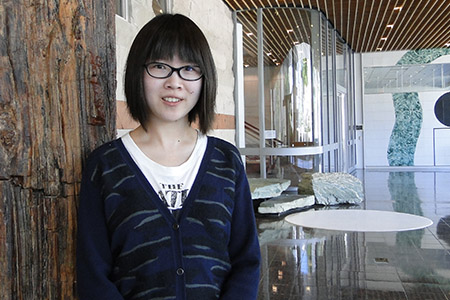
In the last year, China’s air pollution issues have attracted international attention as its government vowed to do something about the thick smog blanketing its cities—a product of the country’s many coal-fired power plants. The news hit close to home for Joint Program graduate student Danwei Zhang, a native of Beijing.
“The challenge is, how can we create enough energy to support so many people in a sustainable way?” says Zhang, a student in the Technology and Policy Program in MIT’s Engineering Systems Division.
For Zhang, part of the solution is renewable energy. She studies the role of renewable energy technologies like wind, solar, biomass, and nuclear in creating a cleaner electricity mix.
Governments and investors worldwide have shown increased attention in renewables as low-carbon alternatives to traditional electricity generation. Although they are cleaner sources of power, renewable technologies are not without their problems; currently they are still expensive, and intermittency issues limit their use to only a percentage of the electricity mix. Zhang studies how to create an energy mix that is both efficient and cost effective, and the policies governments can put in place to encourage such a mix.
Challenges of Financing Renewable Energy
A second year graduate student, Zhang was originally interested in studying finance. It was only in her senior year at Tianjin University in China when searching for an undergraduate thesis topic that she seriously considered studying energy issues. Her father, an energy economist himself, influenced her decision by suggesting that she turn her studies toward energy.
“My father has always encouraged me to use my knowledge of finance to study energy. So, during my senior year, I implemented a study on the financial aspects of renewable energy development in China. I thought it was so interesting that I switched to energy research," she says.
Zhang’s undergraduate research opened her eyes to the challenges renewable companies face when trying to compete with traditional electricity generation. In China, she says, most wind and biomass electricity projects enjoy support from a feed-in tariff or other form of government support. The program is financed by an electricity surcharge paid for by consumers. As more renewable electricity feeds into the grid, the surcharge must also increase, for example, by raising the electricity bills of households and companies. This effectively sets a limit on the amount of renewable electricity in China.
Zhang spent the summer in Beijing, where she interviewed government officials, energy experts, and energy company managers to learn about the low- carbon transformation of China’s electricity system. The interviews will focused on the role of natural gas in comparison to other low-carbon energy sources, such as renewables and nuclear.
She will also investigated whether the targets that China has set for renewables are achievable.
“I’m interested in learning people’s perspectives on energy transformation because there are different pathways to achieving this goal,” Zhang says. “Some have said that we need to improve energy efficiency instead of encouraging large-scale penetration of renewables, but others believe renewables are the most important option for China.”
Zhang also studied new approaches to setting prices for coal power, which meets about 75 percent of China’s electricity need. Coal seems inexpensive in comparison to renewables, but the prices that consumers pay don’t reflect the cost of the environmental and health problems from the resulting pollution. Zhang investigated the ways that China might incorporate these costs into the price of coal power to make renewables more competitive.
Paths to a Low-Carbon Electricity Supply
At the Joint Program, Zhang’s graduate research focuses on different paths toward a low-carbon electricity supply—whether through increased use of nuclear power, switching to renewables like wind, solar, and biomass, or a mix of all of the above. In her first year she readjusted how the EPPA model treats biomass energy.
“Electricity from biomass should be treated more like conventional electricity, because it doesn’t have the same intermittency problems that wind and solar have,” she says. “But where it differs from conventional electricity is that it’s very expensive and people won’t just switch to it without a feed-in tariff and other subsidy programs.”
In the next year, Zhang will compare how different renewable technologies stack up. She has already completed research on how the growing nuclear power resource in China will affect carbon emissions. She has also begun to analyze wind intermittency issues in the US. Next, she plans to develop the EPPA model’s ability to characterize wind power across multiple regions.
Zhang says the broad scope and collaborative nature of the Joint Program make large-scale comparisons like this possible.
“The Joint Program’s integrated approach to looking at energy issues has helped me to look at big questions about how energy and climate are related,” she says. She also credits generous support from BP, and her advisor Sergey Paltsev with making her research possible.
Danwei Zhang is pursuing a Master’s Degree in the Technology and Policy Program at MIT’s Engineering Systems Division. She was the 2013–2014 BP Climate and Energy Fellow.

